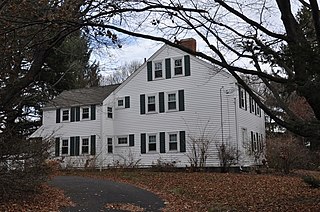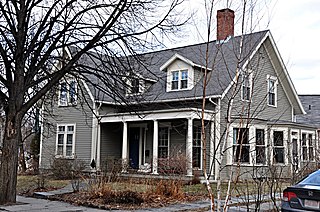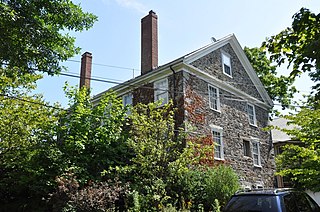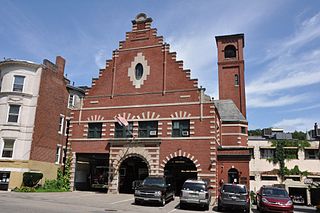
Brookline is a town in Norfolk County, Massachusetts, United States, and part of the Boston metropolitan area. Brookline borders six of Boston's neighborhoods: Brighton, Allston, Fenway–Kenmore, Mission Hill, Jamaica Plain, and West Roxbury. The city of Newton lies to the west of Brookline. Brookline was first settled in 1638 as a hamlet in Boston, known as Muddy River; it was incorporated as a separate town in 1705.

The Isaac Hobbs House is a historic colonial house in Weston, Massachusetts. It was built about 1749 by Ebenezer Hobbs, a prominent local citizen. His son Isaac was a veteran of the American Revolutionary War and owner of an adjacent tannery that was an important local business. The house was listed on the National Register of Historic Places in 1982, and included in the Kendal Green Historic District on March 1, 2000.

The Joseph Bancroft House is a historic house in Reading, Massachusetts. Built in the early 1830s, it is a prominent local example of Federal period architecture. It was built for a member of the locally prominent Bancroft family, who inherited a large tract of land in the area. The house was listed on the National Register of Historic Places in 1984.

The Jonas Cowdry House is a historic house at 61 Prospect Street in Wakefield, Massachusetts. Built c. 1833, the Federal style wood-frame house is three bays wide and four deep, a significant local variant to conventional Federal style architecture. The house was listed on the National Register of Historic Places in 1989.

The William Ingersoll Bowditch House is a historic house at 9 Toxteth Street in Brookline, Massachusetts. It is a good example of vernacular Gothic and Greek Revival architecture, built c. 1844-45 as part of one of Brookline's earliest formal residential subdivisions. William Bowditch, the first owner, was an active abolitionist who sheltered fugitive slaves as part of the Underground Railroad, and was a member of the Boston Vigilance Committee. The house was listed on the National Register of Historic Places on October 17, 1985.

The Brookline Town Green Historic District encompasses the historic colonial heart of the town of Brookline, Massachusetts. Centered on a stretch of Walnut Street between Warren and Chestnut Streets, this area is where the town's first colonial meeting house and cemetery were laid out, and was its center of civic life until the early 19th century. The district was listed on the National Register of Historic Places in 1980.

The Candler Cottage is a historic house at 447 Washington Street in Brookline, Massachusetts. Built about 1850, it is one of the town's few examples of Gothic Revival architecture. It was listed on the National Register of Historic Places in 1985.

The Timothy Corey House No. 2 is a historic house at 786–788 Washington Street in Brookline, Massachusetts. Built in 1843, it is one of Brookline's few stone houses. It is a vernacular Greek Revival in style, and was home to members of one of the town's most prominent early families. It was listed on the National Register of Historic Places on October 17, 1985.

The Robert S. Davis House is a historic house at 50 Stanton Road in Brookline, Massachusetts. Built about 1859 for the scion of a locally prominent family, it is one of the town's best-preserved examples of Italianate architecture. It was listed on the National Register of Historic Places in 1985.

The Edward Devotion House is a historic house at 347 Harvard Street in Brookline, Massachusetts, USA. Built about 1745, it is one of the town's few surviving 18th-century structures, and is of those the best preserved. The house is owned by the town and administered by the Brookline Historical Society as a historic house museum. It was listed on the National Register of Historic Places in 1978.

The General Simon Elliot House is a historic house at 61 Heath Street in Brookline, Massachusetts. Built in 1824, it is one of the town's oldest examples of Greek Revival architecture, owned by several prominent residents. The house was listed on the National Register of Historic Places on October 17, 1985.

Fire Station No. 7, also known as the Washington Square Station, is a historic fire station at 665 Washington Street in Brookline, Massachusetts. Built in 1898, it is an architecturally eclectic mix of Dutch and Renaissance Revival styles. The building was listed on the National Register of Historic Places in 1985. It presently houses Engine 3 and a paramedic ambulance.

The House at 156 Mason Terrace in Brookline, Massachusetts, is one of the most elaborately decorated houses on Corey Hill. The 2–1/2 story wood-frame house was built c. 1888–90, and has classic Queen Anne and Stick style details, including a turret with polygonal roof, porch with Stick decorations, and the variety of gables and projecting sections that typify Queen Anne styling. The house was built on land owned by Thomas Griggs, and was in 1890 sold to James Dunbar, a judge.

Saint Mary of the Assumption Church, Rectory, School and Convent is a historic church complex at 67 Harvard Street, and 3 and 5 Linden Place, in Brookline, Massachusetts. It was the first Roman Catholic church in Brookline, and the first in the nation to bear the name. Most of its buildings were built between 1880 and 1906, and are reflective of the growth of the area's Irish immigrant community during that time. The complex was listed on the National Register of Historic Places in 1985.

The Eliphalet Spurr House is a historic house located at 103 Walnut Street in Brookline, Massachusetts, United States.

The White Place Historic District is a historic district on White Place between Washington Street and Davis Path in Brookline, Massachusetts. White Place contains the town's highest concentration of vernacular 19th-century architecture, with 36 houses built between c. 1835 and 1905. Most of these are single-story or 1+1⁄2-story cottages, which were built before 1866, and exhibit elements of Italianate styling, derived either from the time of their construction, or through later alteration. There are seven triple decker apartment houses, which were built between about 1895 and 1905.

Kilham & Hopkins was an architectural firm in Boston, Massachusetts formed in 1899 or 1900 by its founding members, Walter Harrington Kilham and James Cleveland Hopkins. The firm later became Kilham, Hopkins & Greeley after William Roger Greeley joined the firm in 1916, and Kilham Hopkins Greeley and Brodie after Walter S. (Steve) Brodie joined the firm in 1945.

Fort Hill is a 0.4 square mile neighborhood and historic district of Roxbury, in Boston, Massachusetts. The approximate boundaries of Fort Hill are Malcolm X Boulevard on the north, Washington Street on the southeast, and Columbus Avenue on the southwest.

The Rockwood Road Historic District encompasses a portion of the town center of Norfolk, Massachusetts that has retained significant 19th-century characteristics. It extends along Rockwood Road from the MBTA Commuter Rail line to Boardman Street. This area consists mainly of residential or former residential buildings, as well as the 1863 Norfolk Grange Hall, a former church, and is reflective of the center's growth as a railroad village. The district was added to the National Register of Historic Places in 2017.

Corey Hill is a neighborhood of Brookline, Massachusetts, centered on a homonymous hill rising 260 ft above sea level directly adjacent to the Boston neighborhood of Brighton. The neighborhood takes its name from Timothy Corey, a farmer and soldier of the American Revolutionary War who settled on the hill in the 1760s.























